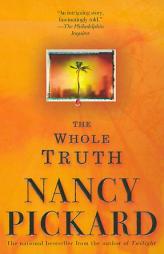
Details
Rent The Whole Truth
Author:
Format: Mass Market Paperback
Publisher: Pocket Books
Published: May 2001
Genre: Fiction - Mystery & Detective - General
Retail Price: $6.99
Synopsis
With The Whole Truth, Nancy Pickard taps neatly into our national fascination with true crime in a daring novel that seems structurally and philosophically at odds with the conventional mystery story. We know, apparently, 'who did it'--as do most true crime readers. People who pick up Ann Rule's The Stranger Beside Me, for example, are usually aware that Ted Bundy was the man responsible for the murders she chronicles. We come to those texts after the fact, as it were; we search not for perpetrator, but for motivation, for explanation. How could these things have happened? What sort of monsters must such criminals be? Pickard's is just such an exploration: it opens with the conviction of one Raymond Raintree for the murder of six-year-old Natalie McCullen, a crime that has shocked South Florida. Marie Lightfoot is in attendance, waiting for the words that will bring to an end The Little Mermaid, the book she is writing about the McCullen case.
However, though it appears her conclusion is written, Marie is deeply worried about the rest of her book: '[Raintree] has no past that anybody, including me, has been able to find. This is not good news for a true crime writer with a book due on her editor's desk in two weeks.' But when Ray escapes just after the verdict is read, Marie must accelerate her quest for Ray's actual and emotional origins. Her search has repercussions that lie far beyond the successful completion of her book; she alone can prevent Ray from killing again. Her questions, and their answers, will take her from Florida to the American heartland, from sunshine and palm trees to an unspeakable history of abduction and abuse.
In an intriguing and effective narrative device, Pickard alternates chapters of her 'own' text with chapters from The Little Mermaid. This structural twinning hints at the plurality of experience, of the conflicting stories that we create to situate ourselves and others; in realizing that writers must sift through the truth, or truths, to create a coherent narrative, the reader must also sift through the sometimes dovetailing, sometimes elliptical relationship between Pickard's and Lightfoot's stories. The strategy is not wholly successful; at times Pickard introduces elements that lead nowhere, such as Marie's uneasy acceptance of her own parents' disappearance years before; at other times, an apparent impulse to accelerate the action serves only to accentuate gaping holes in the plot. But these are minor complaints; Pickard's novel is, in its quiet fashion, an appealing novelty at the intersection of truth and fiction. --Kelly Flynn
